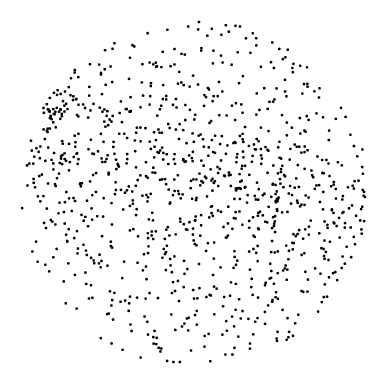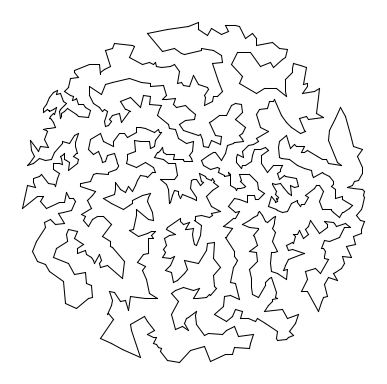1,000 points optimal tour
Perspective. The importance of the TSP does not arise from an overwhelming demand of salespeople to minimize their travel distance, but rather from a wealth of other applications such as vehicle routing, circuit board drilling, VLSI design, robot control, X-ray crystallography, machine scheduling, and computational biology.
- In-Order heuristic: Insert the next point at the end of the current tour. This heuristic is very useful for testing since it is among the simplest to implement, and it is easy to work out the solution by hand.
- Nearest neighbor heuristic: Read in the next point, and add it to the current tour after the point to which it is closest. (If there is more than one point to which it is closest, insert it after the first such point you discover.)
- Smallest increase heuristic: Read in the next point, and add it to the current tour where it will cause the shortest detour, i.e. where it results in the least possible increase in the tour length. (If there is more than one point, insert it after the first such point you discover.)
Study the Point.java API. Its main() method reads in data from standard input in the TSP input format and draws the points to standard draw.
Point.java represents a point in the plane, as described by the following API:
public class Point (2D point data type)
---------------------------------------------------------------------------------------
Point(double x, double y) // create the point (x, y)
String toString() // return string representation
void draw() // draw point using standard draw
void drawTo(Point that) // draw line segment between the two points
double distanceTo(Point that) // return Euclidean distance between the two points
public interface TourInterface
------------------------------------------------------------------------------------------------------
public String toString() // create a String representation of the Tour.
void draw(Point p) // draw the tour to standard draw
// any edge starting or ending at p should be in a distinct color
int size() // number of points on tour
double distance() // return the total distance of the tour
void insertInOrder(Point p) // insert p at the end of the tour
void insertNearest(Point p) // insert p using nearest neighbor heuristic
void insertSmallest(Point p) // insert p using smallest increase heuristic
It is easiest done via the following steps
Our strong suggestion is to create a Node inner class and keep an instance variable (field) called Node head. For an example of this look at LinkedStackOfStrings.java which can be found on booksite at link.
Constructors
Write the following two constructors, both public:- public Tour(); // Create an empty Tour
- public Tour(Point a, Point b, Point c, Point d); // Create
a Tour with the four
points a, b, c, d in that
order. This constructor is useful for debugging. Your
linked list structure for this case should match the
following figure:

// main method for testing
public static void main(String[] args) {
// define 4 points forming a square
Point a = new Point(100.0, 100.0);
Point b = new Point(500.0, 100.0);
Point c = new Point(500.0, 500.0);
Point d = new Point(100.0, 500.0);
// Set up a Tour with those four points
// The constructor should link a->b->c->d->a
Tour squareTour = new Tour(a, b, c, d);
// Output the Tour
System.out.println(squareTour);
}
(100.0, 100.0) (500.0, 100.0) (500.0, 500.0) (100.0, 500.0)
in your main() before you call the Tour draw() method. The four point example above should produce a square.StdDraw.setXscale(0, 600); StdDraw.setYscale(0, 600);
You should see the following output when running insertInOrder() on tsp10.txt and tsp1000.txt (you should comment out the animation lines or speed the animation up a lot in OrderInsertion before attempting tsp1000.txt. You will also need to change a conditional in the main function that does not print tours of size greater than 20. )
> java OrderInsertion tsp10.txt (110.0, 225.0) (161.0, 280.0) (325.0, 554.0) (490.0, 285.0) (157.0, 443.0) (283.0, 379.0) (397.0, 566.0) (306.0, 360.0) (343.0, 110.0) (552.0, 199.0) Tour distance = 2586.6759 Number of points = 10 |
> java OrderInsertion tsp1000.txt (185.0411, 457.8824) ... (334.9344, 524.7824) (396.0952, 150.0943) (462.1732, 486.3889) (193.5595, 527.8311) (331.8716, 533.5717) (748.401, 462.4281) (94.0231, 544.9736) (254.982, 302.2548) Tour distance = 327693.7622 Number of points = 1000 |
||
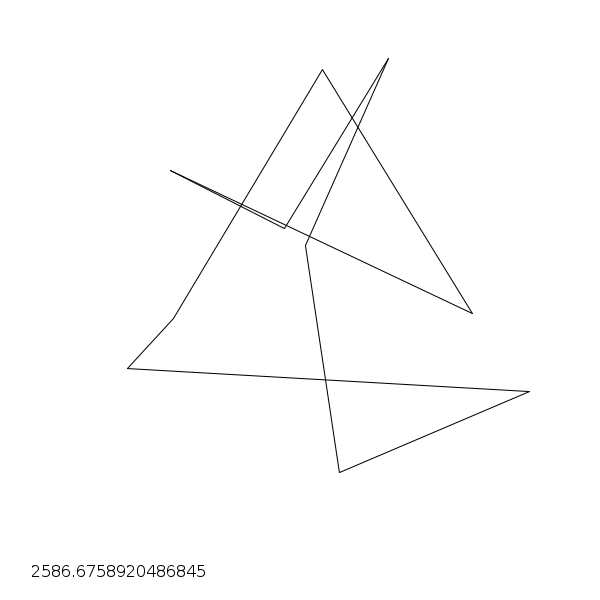 |
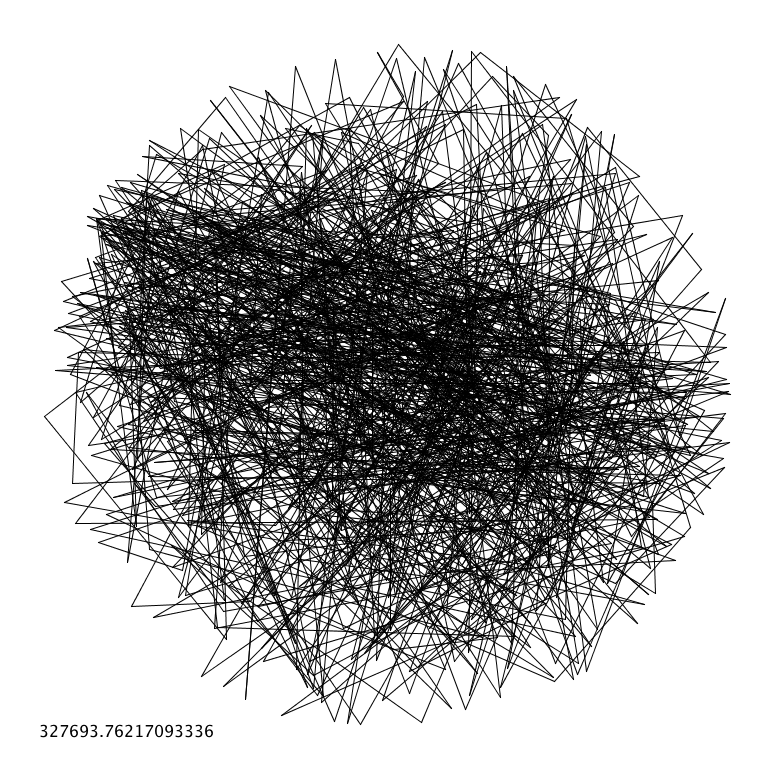 |
As a check, tsp10-smallest.ans contains the result tour, which has distance 1655.7462. In this case, the smallest insertion heuristic actually does worse than the nearest insertion heuristic (although this is not typical)
775 768 185.0411 457.8824 247.5023 299.4322 701.3532 369.7156 563.2718 442.3282 144.5569 576.4812 535.9311 478.4692 383.8523 458.4757 329.9402 740.9576 ... 254.9820 302.2548
- After implementing Tour.java, use the client program
NearestInsertion.java to
read in the points from standard input, run the nearest neighbor
heuristic; print the resulting tour, its distance, and its number
of points to standard output; and draw the resulting tour to
standard draw.
SmallestInsertion.java is
analogous but runs the smallest insertion heuristic.
> java NearestInsertion tsp1000.txt (185.0411, 457.8824) (198.3921, 464.6812) (195.8296, 456.6559) (216.8989, 455.126) (213.3513, 468.0186) (241.4387, 467.413) (259.0682, 473.7961) (221.5852, 442.8863) ... (264.57, 410.328) Tour distance = 27868.7106 Number of points = 1000
> java SmallestInsertion tsp1000.txt (185.0411, 457.8824) (195.8296, 456.6559) (193.0671, 450.2405) (200.7237, 426.3461) (200.5698, 422.6481) (217.4682, 434.3839) (223.1549, 439.8027) (221.5852, 442.8863) ... (186.8032, 449.9557) Tour distance = 17265.6282 Number of points = 1000
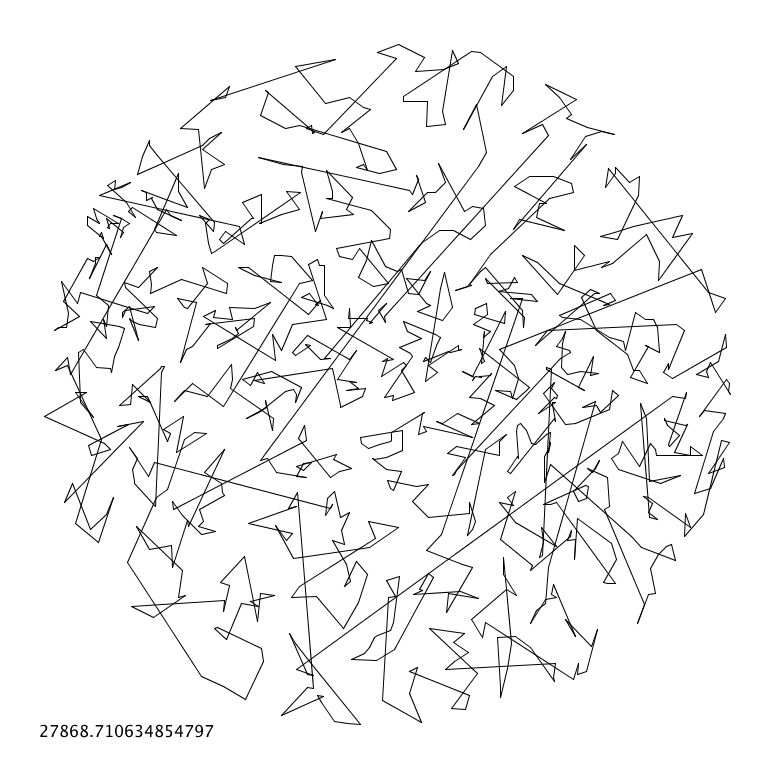
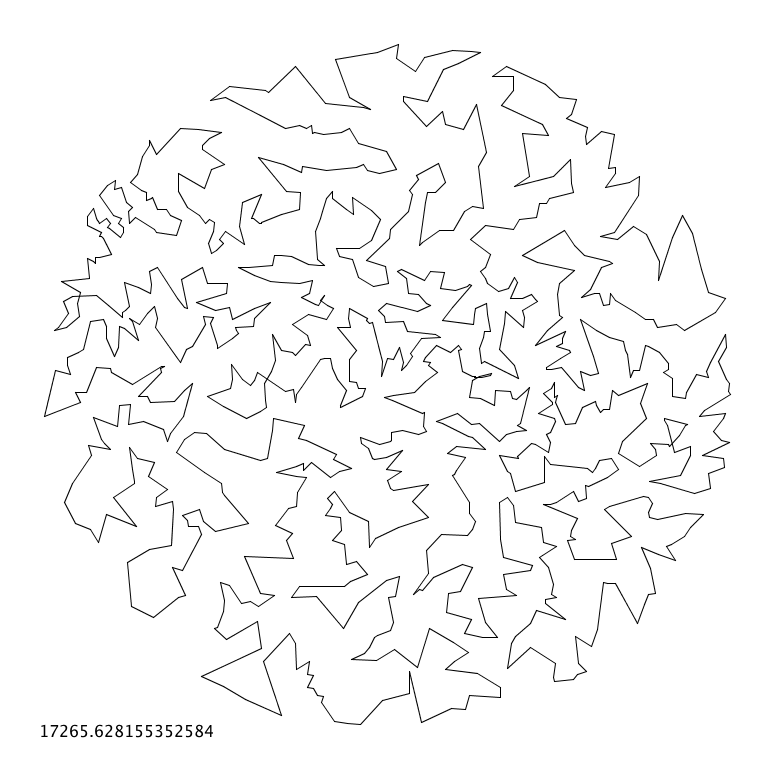
- Note that NearestInsertion and SmallestInsertion only print out the tour if it contains fewer than 20 points. This makes them a bit more practical for large data sets.
- By default, NearestInsertion and SmallestInsertion will both add points at a rate of 4 points/second, and will animate the tour as it grows. If you implemented Tour.draw() correctly, the edges that were just added at each step will be a different color from your other edges. Change the delay in the call to StdDraw.show() to change the animation speed, or comment out the four lines controlling animation entirely to diable it. These lines are clearly commented in each program.
- Note: Remove or comment out any debugging print statements before testing the large input files or your program will take forever to run. Large inputs will produce so much debug output you won't be able to interpret it anyway. If you want to animate large input files, you might also want to modify the animation to only redraw every 20 insertions.
- If you'd like to check your work, for usa13509.txt we get distances of 77449.9794 and 45074.7769 for nearest insertion and smallest insertion, respectively. For circuit1290.txt we get 25029.7905 and 14596.0971.
- Use TSPTimer.java to run the nearest and smallest heuristics for N = 1,000, and repeatedly double N until you reach 128000. Just compile TSPTimer and run it with N as the only command line argument. You should be able to reason about whether each heuristic is logarithmic, linear, n log n, quadratic, cubic, etc., then verify that the actual times fit the expected pattern. Document the times in your readme file.
- When timing your programs, TSPTimer does not animate the results on the screen because this would be a major bottleneck.
- The best known tour for tsp1000.txt is a solution of length 15476.519, which was found using the Concorde TSP solver.
- Georgia Tech's TSP site contains a wealth of interesting information including many applications of the TSP and two TSP games.
- Here's a 13,509 city problem that contains each of the 13,509 cities in the continental US with population over 500. The optimal solution was discovered in 1998 by Applegate, Bixby, Chvatal and Cook using theoretical ideas from linear and integer programming. The following 15,112 city problem was solved to optimality in April, 2001, and is the current world record. It took 585,936,700 CPU seconds (along with a ton of cleverness) to find the optimal tour through 15,112 cities in Germany.
- Some folks even use the TSP to create and sell art. Check out Bob Bosch's page. You can even make your own TSP artwork.
- Here is a New York Times article on finding an optimal traveling politician tour in the state of Iowa.
- Here's a survey article on heuristics for the TSP.
